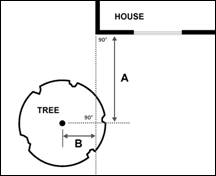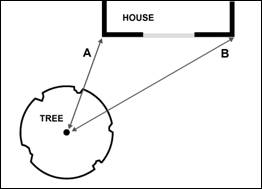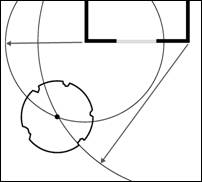This article was written by Len Hordyk, DynaScape Product Manager – Design Solutions. Len has over 20 years of experience in the landscape industry.
As a landscape designer, I’ve often come across site measurements taken by others that leave much to be desired. Taking proper site measurements is all about knowing which ones are the critical dimensions you need, and how to take them. Having the right equipment helps too!
Measurement Tools
Must-have tools for the trade include a small retractable tape measure, a large 100’ (30m) open reel tape and a flat screwdriver. The screwdriver is to hold the end of the large tape by shoving it through the end loop and into the ground (eliminating the need for a second person). You can also use a measuring wheel, but it’s not going to give you the most accurate measurements.
Methods
Measuring a house and other straight or square objects will generally only require single measurements (i.e. measure from house corner to window edge, window width and so on) as you make your way around the house. This is easy stuff. You can also take a running measurement from the corner of the house and pick up the edges of the windows and doors along the way until you reach the other corner. If the house is large, use the big tape and screwdriver.
For almost all other objects you will need to take two measurements to properly document their location. Things like angled property lines, trees, and sheds fit this category and there are two methods you can use to measure them:
Rise and Run Method: This is my preferred method and it’s easy to do by yourself. For this method, you need a house or building to work off of. Take measuring a tree in a front yard as an example. The first step is to measure down to the tree keeping yourself square with the wall of the house (A) and then measure across to the tree (B). To measure to the tree, line the end of your tape measure up with the side of the house, and hold your tape measure at 90° to that line to get the distance to the tree. These two dimensions are easy to translate when drafting the base plan later.

Triangulation Method: This method is very accurate and also easy to translate to your base plan drawing, especially when using CAD software. To triangulate you need two fixed points and the corners of a house typically work best. First, measure from one corner (A) and then the other (B) – see Figure 2. If you are by yourself, you will need the long tape and screwdriver here (having another pair of hands and two long tapes will also make it go a little faster). To translate the measurements onto your base plan back at the office, use circles, with the dimensions to the tree as the radius of the circles. Where the two circles intersect is the exact location of the tree – see Figure 3. This method also works great for figuring out the location of the corners on an angled lot.


Take Critical Measurements
Having a lot of measurements isn’t helpful if the critical ones are missing. For example, if you have angled property lines, you should take two measurements from the corners of the house for each of them. This will give you the correct angles and you won’t have to measure to the corners – the corners will be wherever the lines intersect.
Other Helpful Tips
Learn to Sketch Proportionally: Take a few extra minutes to sketch the site in proportion as much as possible. This will help you translate the dimensions later at the office into your landscape design software. Use a pencil and eraser as opposed to a pen.
Take Lots of Photos: If you miss a measurement, you can often figure it out from photos. Think about taking photos from a number of angles to help you out if this should happen. With digital cameras pictures are free!
Ask for a Lot Plan: If you can get a lot plan (survey) beforehand, print it out and take it with you to put your site measurements on. Some lot plans have a fair bit of information on them, often including fences and trees. But they don’t have doors and windows on them, so you will still have to do some measuring. Also, they generally only have measurements to the front property line, not the road and sidewalk – you’ll have to take those as well.
Measure Critical Grade Changes: If your landscape plan will include hardscape elements like a walkway, deck, or pool, make sure that you measure the grade changes that will affect the design. For a front walkway, the critical measurement is the change in grade from the front door to the driveway. For pools, it is usually best to take surveying equipment like a transit or laser level on site to capture the grade information accurately. Contractors don’t like adding steps or retaining walls where they haven’t accounted for them on their estimate.